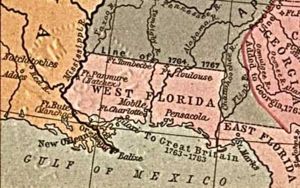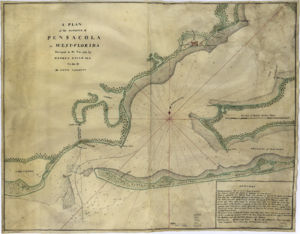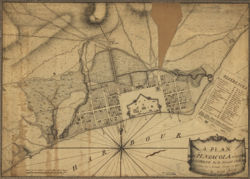British Pensacola
Pensacola was under British control, and served as the capital of its West Florida territory, from 1763 until 1781.
Britain's most lasting contribution to Pensacola was a city plan and street grid, laid out by Elias Durnford in 1764, which remains largely intact to the present day. Britain also introduced the slavery-based cotton plantation system to the area, which, as with Britain's other colonies in what is now the southern United States, came to dominate the area's economy prior to the American Civil War.
Contents
History[edit]
British acquisition[edit]

Great Britain came into possession of Pensacola, and the rest of Florida, as a result of the Treaty of Paris (1763), which ended the French and Indian War, the North American component of the wider Seven Years' War. Britain organized its new holdings into two territories: East Florida, which comprised modern Florida east of the Apalachicola River, with its capital at Saint Augustine; and West Florida, which comprised the portions of Louisiana, Mississippi, Alabama, and Florida that laid south of the 31st parallel and between the Mississippi and Apalachicola Rivers. In 1764, the British moved the northern boundary up to 32° 28′ north, absorbing the southern thirds of modern-day Mississippi and Alabama.
Britain took official possession of Pensacola on August 7, 1763, when a Captain Wills of the Third Battery of the Royal Artillery arrived from Havana to receive Pensacola from the Spanish commandant. On September 3 Spain evacuated its troops and the town's citizens to Vera Cruz.[1]
According to a report written by Captain Wills, the town at that time consisted of "40 huts, thatched with palmetto leaves, and barracks for a small garrison, the whole surrounded by a stockade of pine posts." Wills went on to describe the terrain:
- "The country, from the insuperable laziness of the Spaniards, still remains uncultivated. The woods are still near the village, and a few paltry gardens show the only improvements. Stock, they have none, being entirely supplied by Mobile, which is pretty well cultivated and produces sufficient for export."[2]
Revolutionary War[edit]
In the early 1770s, British colonists in North America began to rebel against Britain, eventually declaring their independence as the United States of America in 1775. Britain, determined not to lose its valuable colonies, attempted to regain them by force, initiating the American Revolutionary War. In 1778, hoping to undermine British world power, France entered the war on the side of the United States.
In 1779, France and Spain signed the Treaty of Aranjuez. Although Spain did not recognize the United States, it agreed under the terms of the treaty to aid France in its war against Britain.
Spain retakes Pensacola[edit]
On March 9, 1781, Spanish Field Marshal Bernardo de Gálvez began an amphibious siege of Pensacola. The siege lasted for two months before Gálvez took the town on May 8. Later that year, British forces under General Charles Cornwallis surrendered to American forces at Yorktown, essentially ending the land war, although British and French naval forces continued to battle at sea. The war officially ended with the Treaty of Paris (1783), at which time Britain ceded East and West Florida to Spain.
British occupation[edit]
City plan[edit]
In 1764, British civil engineer Elias Durnford surveyed the town and laid out a street grid which remains mostly preserved to the present day. British Pensacola centered on a large public space which included modern-day Plaza Ferdinand VII, Seville Square and the space between the two (the area which today lies between Palafox and Alcaniz Streets and south of Intendencia Street). The water line at that time was located approximately where Main Street lies today. Within the public space was a large fort. The fort and its surroundings were the center of public life:
| In the centre of [the public space] was a star-shaped stockade fort, designed as a place of refuge for the population in case of an Indian attack. Near it were the officers' quarters, barracks, guard house, ordinance store-house and laboratory, two powder magazines, the King's bake-house, cooperage shelter, and government store-house. This park was, therefore, in the early days of Pensacola, the liveliest and busiest part of the town. | ||
—Campbell, Richard L. "Historical Sketches of Colonial Florida", 1892. | ||
The British also later constructed Fort George north of the town at Gage Hill, and the Queen's Redoubt to the northwest.
Administration[edit]
During the course of the British occupation, the five successive Crown-appointed governors of West Florida took up residence in Pensacola:
- George Johnstone (1763-1767)
- Montfort Browne (1767-1769)
- John Eliot (1769)
- Elias Durnford (1769-1770)
- Peter Chester (1770-1781)
Commodore George Johnstone of the Royal Navy arrived at Pensacola in February 1764, becoming Pensacola's first British governor.[2] Johnstone, though, became unpopular with settlers due to his faithful enforcement of unpopular British policies such as the Stamp Act. He caused further discord with his policy of aggression toward Indians, and under pressure either resigned or was recalled in December 1766.[2] The lieutenant governor, Montfort Browne, served as governor until his replacement, John Eliot, arrived. Eliot was delayed in England and did not arrive in Pensacola until 1769. However, Eliot was affected by a strange malady, possibly a brain tumor, and committed suicide shortly after arriving in Pensacola. Montfort Browne, who was still serving as lieutenant governor, briefly took charge again, but soon left for England. Elias Durnford thereafter served as governor until Eliot's replacement, Peter Chester, arrived in 1770. Chester served until the Spanish took Pensacola in 1781.
British placenames[edit]
The British named a variety of geographical places, including streets. Most of these names do not survive to the present, as the Spanish and Americans who subsequently occupied Pensacola changed many of the names.
| British placename | Contemporary placename |
|---|---|
| Albemarle Street | Zaragoza Street, west of the public space (west of modern-day Palafox Street) |
| Bute Street | Government Street, east of the public space (east of modern-day Alcaniz Street) |
| Charlotte Street | Alcaniz Street |
| Cumberland Street | Baylen Street |
| Deer Point | Fair Point |
| East Point | Deer Point |
| English Point | Emanuel Point |
| Gage Hill | Gage Hill or North Hill. The Spanish renamed Gage Hill as Mount Miguel when they took control in 1781. Gage Hill has also occasionally been called Palafox Hill. |
| George Street | Palafox Street |
| Granby Street | Intendencia Street, west of the public space (west of modern-day Palafox Street) |
| Gloucester Street | Cevallos Street |
| Gull Point | Gull Point |
| Harcourt Street | Intendencia Street, east of the public space (east of modern-day Alcaniz Street) |
| Indian Point | Garcon Point |
| Johnstone Street | Barcelona Street |
| Lindsay Street | Reus Street |
| Mansfield Street | Zaragoza Street, east of the public space (east of modern-day Alcaniz Street) |
| Pitt Street | Government Street, west of the public space (west of modern-day Palafox Street) |
| Princess Street | Romana Street |
| Red Cliffs | Barrancas |
| Sandy Point | Town Point |
| Tartar Point | Tartar Point |
| York Street | Florida Blanca Street |
Citizens[edit]
- See also: Category:Citizens of British Pensacola
Shortly after the British surrender on May 10, 1781, Spanish occupational forces made a record of British householders to be kept "en caso de reclaman" — "in case of claims." This list likely does not constitute a proper census, as it does not include dependents or attempt to enumerate a total number of citizens.[3]
- =William Clifton, Chief Justice
- =James Bruce, Counseller
- =David Hodge, "
- =John Stephenson, "
- =Captain Johnstone, Military Gentleman of the Council
- =Captn. Rainsford, "
- =Edmund Rush Wegg, Attorney General
- =Elihu Hall Bay, Prove. Secy. &Judge Admty.
- =Alexr. Macullagh, D. Pro. Marshal Genl.
- =J. Allen Martin, Comptr. & Clk Pleas
- =John Morison, Atty. at Law
- ===[Jo]hn Bay, "
- ===Miller, Magistrate
- Arthur Strother, "
- George Gauld, "
- +John Lorimer, "
- William Marshall, "
- John Mitchell, "
- Robert Tait, "
- Arthur Neil, Officer of Ordance [sic]
- +William Wilton, "
- James Amos, "
- +Joseph Purcell, D. Surveyor Genl.
- +William Garden, Commissary
- +Peter Swanson, Merchant
- James Fairlie, "
- +John Falconer, "
- Robert Donald, "
- John Finley, Schoolmaster
- Alexr. Moore, Planter
- +Patrick Strachan, "
- James Kirk, "
- Richard Carr, "
- John Stokes, Baker
- +John Simpson, Tavern Keeper
- John White, Carpenter
- +Isaac White, Taylor
- Thomas Pashley, "
- +Leonard Wisner, [4]
- Vincent Corona, Retail of Liqui=
- George Watson, Ship Carpent[er]=
- +James Oneil, Shop Keeper
- +Stephen Shakespear, "
- Richard Seamark, "
- +Thomas Underwood, House Keeper
- John Moore, barman
- William Duncan, Court Cryer
- James Griest, Pilot
- William Johnson, "
- Jesse Brashier, Yeoman
- +John Glover, Master Carpenter
- Phenix Stephens, Constable
- William Burns , Pilot
- Charles Grant, Carpenter
- +James Aird, "
- William Testard, "
- +Abd=====e, "
- =========rove, "
- Barthw. Besly, "
- James Traviss, "
- Henry Legg, "
- +James Irving, "
- +Barnd. Richardson, "
- +John Amer, Ordnance do. [sic]
- Thos. Kirton, Goaler
- Isham Safford, Depy. Surveyor
- +Mattw. Arnold, Brick layer
- John Hannay, Taylor
- Wm. Walters, Yeoman
- Mrs. Farmar, Widow
- Mrs. Bell, "
- ===[Ca]ptn. Chrystie, Military Housekeeper
- =====Ogden, "
- =====Ramsay, "
- David Halley, "
- +Serjt. Wadman, "
- +Serjt. Burns, "
- +Serjt. Jaisen, "
- +Serjt. Drassen, "
- +Serjt. Porter, "
- +James Murray, Genl. Clerk
- +Leonard Wisner, Black smith[4]
- +Willm. Whissell, "
- +Mary Crozer, Widow
- Notes: = indicates damage to the document that may have rendered some portion illegible. + was a marginal notation next to many of the names, the significance of which is unknown.
Other images[edit]
Notes and references[edit]
- ↑ Hamilton, Peter J. "British West Florida". Publications of the Mississippi Historical Society. Oxford, Miss.: 1903.
- ↑ 2.0 2.1 2.2 Campbell, Richard L. "Historical Sketches of Colonial Florida". The Williams Publishing Co., Cleveland: 1892.
- ↑ William S. Coker and Rodrigo Fernández Carrión. "List of the Inhabitants of Pensacola Who Were Householders at the Time of the Capitulation." Florida Historical Quarterly, Volume 77, Number 1, Summer 1998.
- ↑ 4.0 4.1 Blacksmith Leonard Wisner appears twice on the list. It is unknown if this was an error, or a father and son with the same name.




